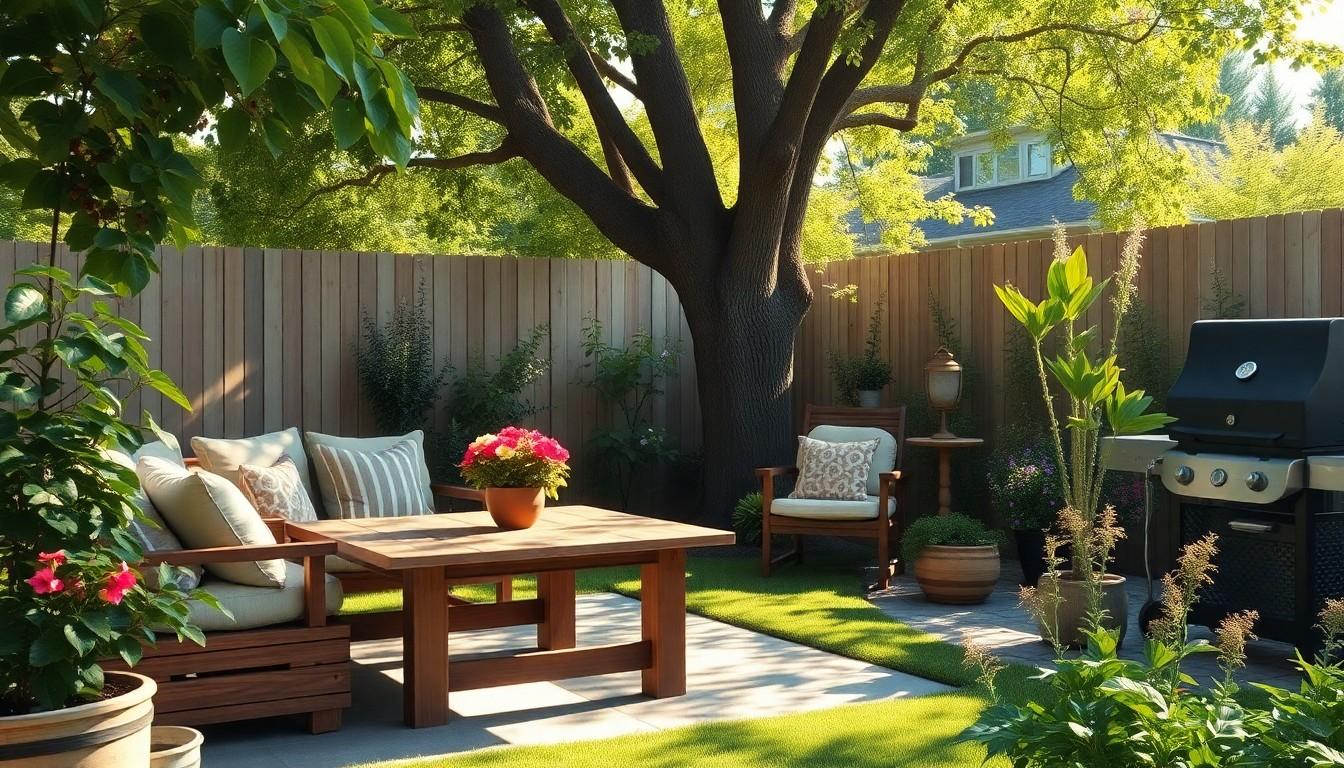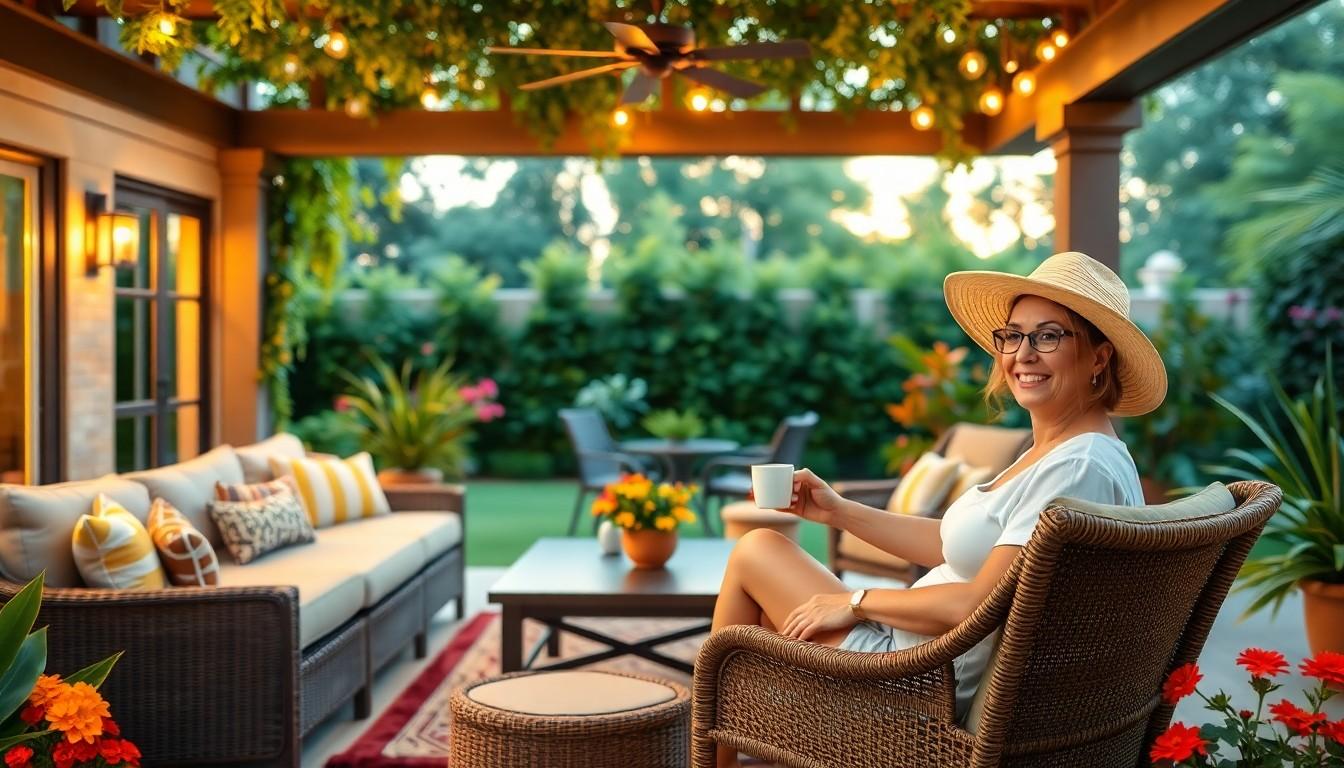Imagine stepping into your backyard and feeling like you’ve just entered a luxurious resort. Designing outdoor living spaces isn’t just about aesthetics; it’s about creating a personal paradise where relaxation meets style. Whether it’s a cozy nook for morning coffee or a vibrant space for weekend barbecues, transforming your outdoors can elevate your lifestyle and impress your guests.
how to design outdoor living spaces
Outdoor living spaces significantly enhance quality of life. They serve as extensions of the home, providing areas for relaxation, entertainment, and connection with nature. Research indicates that access to well-designed outdoor areas can reduce stress and foster well-being. These spaces promote an active lifestyle, encouraging outdoor meals, gatherings, and leisure activities.
Aesthetic appeal plays a crucial role in outdoor living environments. Beautifully designed patios, gardens, and decks invite people to spend more time outside. Functional elements, like seating and cooking areas, bolster social interaction. Families gather for barbecues or play games, making memories in cheerful surroundings.
The value of outdoor spaces extends to property enhancement. Well-maintained gardens and functional patios can increase real estate value by 20 percent or more. Homeowners and buyers alike recognize the allure of inviting outdoor environments. Curb appeal and professional landscaping contribute to first impressions, often influencing property demand.
Incorporating sustainable features benefits both the environment and its inhabitants. Native plants, drip irrigation, and energy-efficient lighting reduce ecological footprints. Sustainable spaces attract more residents looking for eco-friendly options.
Personal well-being thrives in outdoor environments. Engaging with nature boosts mental clarity and creativity, enhancing productivity. Thoughtfully designed areas support relaxation, offering escapes from indoor distractions. Outdoor living spaces cater to diverse needs, reflecting individual lifestyles and preferences. This design trend continues to grow, highlighting the significance of well-considered outdoor spaces.
Planning Your Space

Planning outdoor living spaces involves understanding personal preferences and maximizing the area’s potential. It’s essential to consider how the space can serve different functions, whether for quiet reflection, entertaining guests, or family activities.
Assessing Your Needs
Identifying specific needs makes the design process smoother. Consideration of family size, lifestyle habits, and intended use shapes the initial layout. For instance, if hosting gatherings frequently, ample seating and dining areas become crucial. Evaluating comfort preferences also influences material choice, from cushions to dining sets. Incorporating shaded areas can enhance usability during sunny days. Clarifying these elements allows for a design tailored to individual lifestyles.
Choosing The Right Location
Location significantly impacts the functionality of outdoor living spaces. Sunlight exposure, accessibility from indoors, and integration with existing landscaping dictate the best placements. A southern exposure can provide warmth and ideal conditions for vegetation. Placing spaces near trees or established gardens offers shade and a natural backdrop. Considering sightlines can enhance privacy and aesthetic appeal. Proximity to the home contributes to convenient access, creating a seamless flow between indoor and outdoor areas.
Design Elements To Consider
Designing outdoor living spaces requires careful thought about several key elements, ensuring they meet functional and aesthetic needs.
Furniture Selection
Choosing the right furniture enhances comfort and style in outdoor areas. Select materials that withstand weather conditions, such as aluminum or teak. Ensure seating arrangements accommodate various gatherings, from intimate dinners to lively parties. Consider adding cushions for extra comfort and color. Prioritizing scale also matters; choose furniture that fits the space without overcrowding it. Versatile options like modular seating provide flexibility for different occasions.
Lighting Options
Effective lighting transforms outdoor spaces, allowing for enjoyment after sunset. Incorporate a mix of ambient, task, and accent lighting to create a welcoming atmosphere. String lights add a casual feel, while wall sconces provide elegance. Solar-powered options reduce energy costs and promote sustainability. Utilize pathway lighting for safety and to guide guests effectively. Dimmer switches offer control over brightness, enhancing relaxation or lively get-togethers.
Natural Features
Integrating natural features fosters a connection with the environment. Utilize plants and trees to provide shade and privacy, enhancing comfort in outdoor areas. Water features like fountains or ponds introduce tranquility and visual interest. Rock gardens or raised beds can add texture and vibrancy to the design. Consider using natural materials like stone or wood to create pathways and seating areas. Prioritizing native plants helps sustain local ecosystems, making the outdoor space more eco-friendly.
Creating a Cohesive Aesthetic
Creating a cohesive aesthetic in outdoor living spaces enhances visual appeal and creates an inviting atmosphere. Consistent design elements forge a seamless link between indoor and outdoor areas, fostering a sense of unity.
Color Schemes
Select a color palette that reflects personal style and complements surrounding landscapes. Earthy tones, soft neutrals, or vibrant hues can create specific moods. Use accent colors through cushions, rugs, or planters to add interest while ensuring harmony. Coordination among furniture and decorative elements increases overall cohesion. For example, a soft green sofa paired with bright throw pillows can evoke a refreshing ambiance. Alternatively, using monochromatic schemes with varied shades provides depth without overwhelming the space.
Material Choices
Choose durable materials that withstand outdoor conditions while aligning with the desired aesthetic. Weather-resistant furnishings made from synthetic wicker or powder-coated metals offer longevity. Incorporate natural elements like wood or stone to enhance connection with nature. Diverse textures create visual intrigue; for example, mix smooth tabletops with woven seating. Pairing materials strategically promotes a balanced atmosphere, ensuring comfort alongside style. Emphasizing sustainable options, like reclaimed wood, contributes to eco-friendly design principles while maintaining aesthetic appeal.
Enhancing Functionality
Creating functional outdoor living spaces includes thoughtful zoning and weather considerations. Each element contributes to maximizing use while ensuring comfort.
Zones For Activities
Defining specific zones enhances usability in outdoor spaces. A dining area can accommodate family meals and gatherings. A lounge zone invites relaxation with comfortable seating and pillows. Cooking stations may feature grills or outdoor kitchens, streamlining meal preparation. Incorporating play zones, such as a small playground or an area for games, engages children and adults alike. Each zone must connect logically, encouraging movement between spaces without disruption.
Weather Considerations
Weather affects outdoor space usability, making consideration essential. Using shade structures provides relief from the sun, ensuring comfort during hot months. Windbreaks can protect areas from harsh breezes, creating a cozy atmosphere. Materials also play a role; choosing weather-resistant furniture ensures longevity and durability. Seasonal adjustments may include patio heaters for cooler evenings or misting systems for hot days, enhancing year-round enjoyment. By preparing for various weather conditions, individuals maintain functionality and comfort.
Designing outdoor living spaces is an opportunity to create a personal sanctuary that enhances both lifestyle and well-being. By carefully considering individual preferences and integrating sustainable elements, these spaces can become a true extension of the home.
Thoughtful planning ensures functionality and comfort while fostering connection with nature. As outdoor areas evolve into inviting retreats for relaxation and social gatherings, they not only improve quality of life but can also significantly increase property value.
Embracing this design trend allows for a harmonious blend of style and practicality, encouraging enjoyment of the great outdoors all year round.

